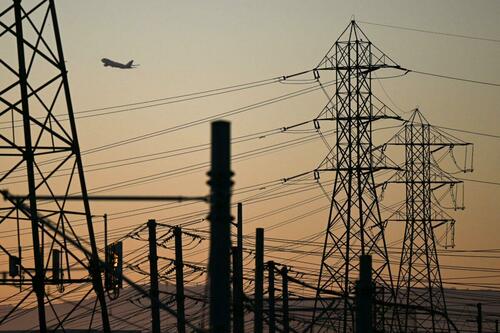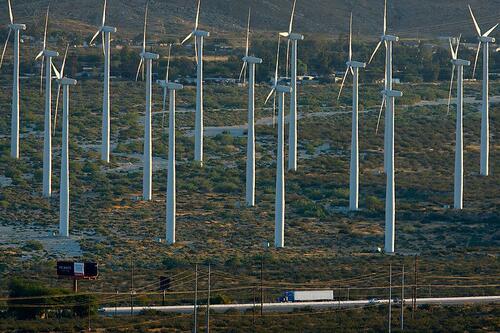Authored by John Haughey via The Epoch Times (emphasis ours),
Hope is a powerful energy, but it won’t keep the air conditioner on when summer temperatures soar and demand for electricity skyrockets, causing an overburdened electrical grid to grind to a stop.

Yet that seems to be the Biden administration’s plan in addressing warnings that nine North American regional electrical grids face an “elevated risk” of power outages this summer, Federal Energy Regulatory Commission (FERC) Commissioner Mark Christie maintains.
“I take it as, ‘We hope we can through the summer. We think we have a chance if the weather is normal,’” he said during a May 18 FERC meeting. “We hope we get all good news this summer.”
Christie was critiquing the U.S. Department of Energy’s (DOE) Office of Energy Policy & Innovation and Office of Electric Reliability responses to the North American Electric Reliability Corporation (NERC)’s annual summer reliability assessment that forecasts brown-outs and black-outs across two-thirds of North America between June and September if there are “wide-area” heat waves, drought, and wildfires.
NERC, a not-for-profit public-private entity staffed with industry representatives, provides the DOE and state regulators with reliability assessments of the electrical grid from Canada to northern Mexico.
The commission is a subsidiary of FERC, which regulates transmission, pipelines, and interstate wholesale prices of electricity and natural gas.
The FERC board consists of five appointed members with one seat currently vacant. There are two Democrats, including Chair Willie Phillips, and two Republicans, including Christie, who was appointed to the commission by President Donald Trump in 2018.

Non-Synchronous Problem is the Solution
In its assessment, NERC cites the “changing resource mix” driven by Biden’s goal to “decarbonize” the U.S. electrical grid by 2035 as spurring a disjointed transition from coal, oil, and natural gas to renewable energies, such as wind, solar, and nuclear.
With electricity demand increasing—it is projected to increase by at least 50 percent by 2050—fossil fuel plants are being retired more quickly than they are being replaced by plants generating electricity from “renewable” green sources, fostering fears of shortages that could see electricity prices soar.
“You’ve heard me say, and you’ve heard me say often, reliability is job one, and that is our focus of many of the orders we have today” including the NERC assessment, Phillips said.
The NERC assessment and other FERC programs address “the rapidly changing resource mix,” but added he is concerned about the “projected addition over the next decade of an unprecedented proportion of non-synchronous resources.”
Those resources include solar, wind, and hydropower, which are “non-synchronous” because they produce different amounts of electricity depending on conditions. Too much reliance on non-synchronous renewable energy generation can decrease overall grid stability, NERC maintains.
Nevertheless, the DOE agencies’ plan to remedy summer storm and heat wave shortfalls is adding more “non-synchronous” energy to the resource mix.
Energy Industry Analyst James Burchill of the Office of Energy Policy & Innovation told the commission that a “warmer than average summer [is] expected this year” with the National Oceanographic Atmospheric Agency forecasting a “50- to 70-percent chance of higher than normal temperatures this summer in most parts of the country.”
Burchill said aggregate net power generation this summer is expected to increase to 1,167 gigawatts (GW) from 1,138 GWs last summer “primarily from solar and wind generation that has been added or will begin service.”
An additional 4 GWs of energy storage capacity has been added nationwide for the second year in a row, “making battery storage the fourth-largest type of capacity addition to the grid by the end of summer 2023,” he said.
“Resource additions outpaced retirements, with rapid growth in storage capacity,” which should suffice in supplementing base grid generation, Burchill said. NERC maintains this should be adequate under normal operating conditions.
“Tracking recent trends,” he said, “much of the added capacity this summer will likely come from wind, solar, natural gas-fired (plants), and battery storage projects while retirements will most be coal-fired.”

‘Good News’ Fueled By Wind, Sun, Hope
NERC Director of Reliability John Moura was less rosy, telling the commission the assessment “found that new resource additions will meet that [normal] demand, but the loss in capacity from retirements is increasing the risk of electricity shortages during wide-area heat waves and other extreme weather conditions.”
To be clear, he said, “All areas meet reliability criteria and have adequate resources for normal demand. However, we also found more areas are likely to have energy risks during the more extreme scenarios that we assess.”
Wind energy, in particular, is a concern, Moura said. “When low-wind factors are factored in” generation in peak demand is “not sufficient.”
“New wind and solar are not one-for-one replacements of retiring fossil plants,” Commissioner Allison Clements said. “They are not intended to create a reliable grid in isolation.”
She said that “properly accrediting the ability of all resource types during shortages is critical to reliability,” which is what the NERC assessment recommends and what is happening.
“It is important that we avoid jumping to conclusions, though, before we collectively kick the tires on the assumptions in this report,” Clements said, highlighting upcoming industry forums in Portland, Maine, and Austin, Texas, as opportunities for experts to find solutions, such as “grid-enhancing technologies.”
Fossil fuel plant retirements “are one important piece of a larger reliability puzzle and solving that puzzle starts with an analysis of all the pieces,” she said.
Phillips, who was heckled by climate change activists in his opening remarks and as the meeting concluded, said that despite concerns over summer outages, “I think there is some good news here. We’re seeing things trending in the right direction over the last year.”
That’s not what Christie said he’s seeing.
“The long-term trends, I don’t think are good news,” he said. “I think we have some major, major threats facing the reliability of the grid. The long-term trend is we are losing dispatchable generation at a rate that is unsustainable and it is going to have negative consequences in the future.”
But there’s the wind, the sun, and the hope that it all works out, Christie said.
“If wind doesn’t show up, there is insufficient dispatchable generating capacity,” he said. “So, we hope it does.”


